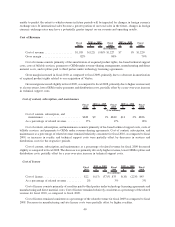Symantec 2010 Annual Report Download - page 110
Download and view the complete annual report
Please find page 110 of the 2010 Symantec annual report below. You can navigate through the pages in the report by either clicking on the pages listed below, or by using the keyword search tool below to find specific information within the annual report.activity in active markets or no active market existing. For those securities where no active market existed,
amortized cost was used and approximates fair value because of their short maturities. For certain financial
instruments classified as Level 2 as of April 2, 2010, we used identical securities for determining fair value.
• Determining which model-derived valuations to use in determining fair value- When observable market
prices for identical securities or similar securities are not available, we may price marketable securities
using: non-binding market consensus prices that are corroborated with observable market data; or pricing
models, such as discounted cash flow approaches, with all significant inputs derived from or corroborated
with observable market data. In addition, the credit ratings for issuers of debt instruments in which we are
invested could change, which could lead to lower fair values. As of April 2, 2010, the fair value of $6 million
of fixed-income securities was determined using benchmark pricing models for identical or similar
securities.
As of April 2, 2010, we have no financial instruments with unobservable inputs classified in Level 3 under the
hierarchy set forth under the authoritative guidance on fair value measurements. Level 3 instruments generally
would include unobservable inputs to be used in the valuation methodology that are significant to the measurement
of fair value of assets or liabilities. The determination of fair value for Level 3 instruments requires the most
management judgment and subjectivity.
Stock-based Compensation
We account for stock-based compensation in accordance with the authoritative guidance on stock compen-
sation. Under the fair value recognition provisions of this guidance, stock-based compensation is measured at the
grant date based on the fair value of the award and is recognized as expense over the requisite service period, which
is generally the vesting period of the respective award.
Determining the fair value of stock-based awards at the grant date requires judgment. We use the Black-
Scholes option-pricing model to determine the fair value of stock options. The determination of the grant date fair
value of options using an option-pricing model is affected by our stock price as well as assumptions regarding a
number of complex and subjective variables. These variables include our expected stock price volatility over the
term of the options, actual and projected employee stock option exercise and cancellation behaviors, risk-free
interest rates, and expected dividends.
We estimate the expected life of options granted based on an analysis of our historical experience of employee
exercise and post-vesting termination behavior considered in relation to the contractual life of the option. Expected
volatility is based on the average of historical volatility for the period commensurate with the expected life of the
option and the implied volatility of traded options. The risk free interest rate is equal to the U.S. Treasury constant
maturity rates for the period equal to the expected life. We do not currently pay cash dividends on our common stock
and do not anticipate doing so in the foreseeable future. Accordingly, our expected dividend yield is zero.
In accordance with the authoritative guidance on stock compensation, we only record stock-based compen-
sation expense for awards that are expected to vest. As a result, judgment is also required in estimating the amount
of stock-based awards that are expected to be forfeited. Although we estimate forfeitures based on historical
experience, actual forfeitures may differ. If actual results differ significantly from these estimates, stock-based
compensation expense and our results of operations could be materially impacted when we record a true-up for the
difference in the period that the awards vest.
Contingencies and Litigation
We evaluate contingent liabilities including threatened or pending litigation in accordance with the author-
itative guidance on contingencies. We assess the likelihood of any adverse judgments or outcomes from a potential
claim or legal proceeding, as well as potential ranges of probable losses, when the outcomes of the claims or
proceedings are probable and reasonably estimable. A determination of the amount of accrued liabilities required, if
any, for these contingencies is made after the analysis of each separate matter. Because of uncertainties related to
these matters, we base our estimates on the information available at the time of our assessment. As additional
information becomes available, we reassess the potential liability related to its pending claims and litigation and
34
























